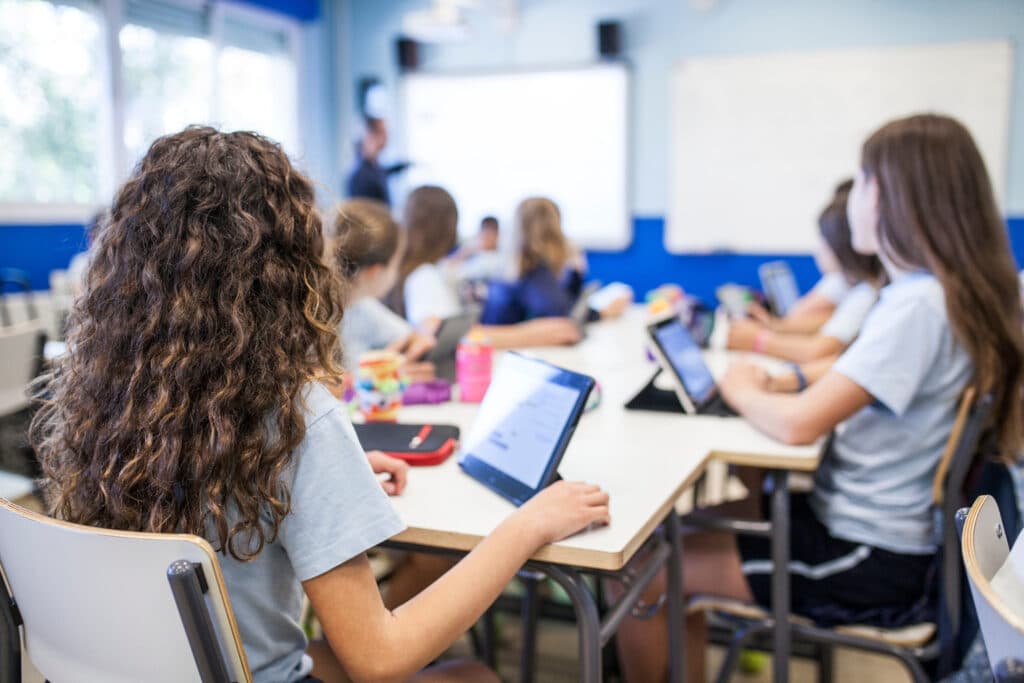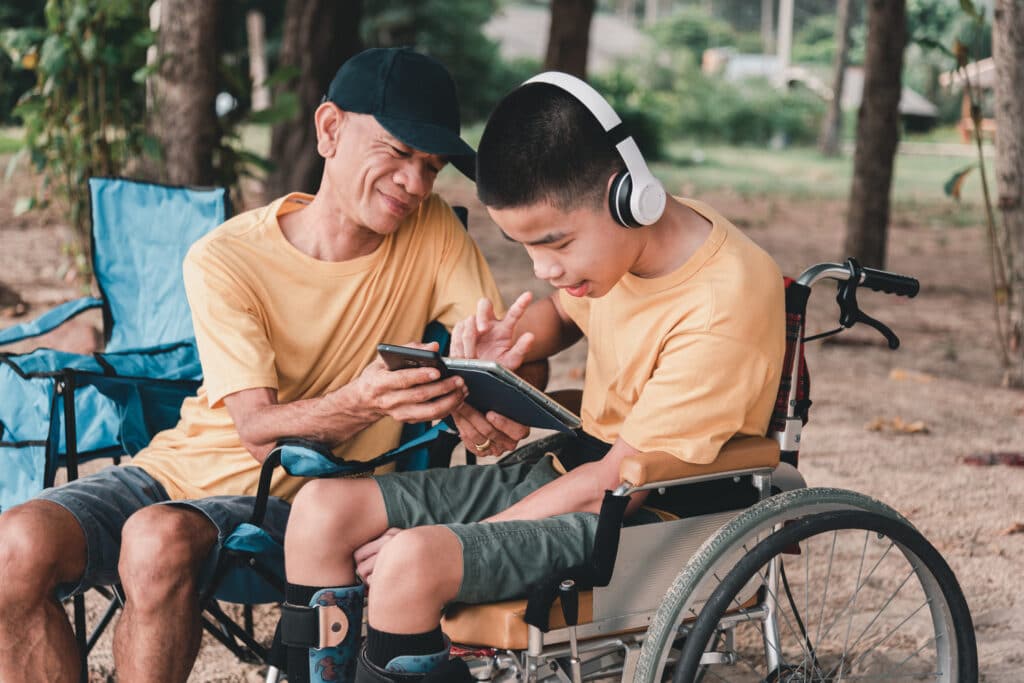How we define technology has evolved over the centuries — what we find commonplace today was once high-tech and innovative. Since we started putting together simple machines and devices, children have been drawn to technology and all its bells and whistles.
From the invention of mechanical calculators to classic video games to educational websites or phone apps, kids have always sought a relationship with technology.

Today, schools integrate technology into their curricula, empowering children to access knowledge like never before. Assistive technologies have also allowed students of all abilities to learn together, a previously impossible feat due to most learning materials only being available in print.
So, what does this mean for kids and the future of technology?
The History of Kids & Technology
Over the past few decades, technology has woven itself into nearly every facet of our lives, extending its influence to the youngest members of our society: children.
This has reshaped our lifestyles, how we earn our livelihoods, and even how we connect with one another.
Nowadays, the array of technological wonders available to kids is vast. From the days of handheld game consoles to the current era of smartphones and tablets, this generation has an unprecedented wealth of tech at their fingertips — a stark contrast to any prior time in history.
Yet, the story of children interacting with technology goes back further than you may think.
Even back in the 19th century, the allure of technology was evident through the enchantment sparked by mechanical toys. Simple machines and robot prototypes have been staples of children’s toy boxes for centuries.
As technology’s capabilities advanced, children’s playthings evolved in tandem, reflecting the cutting-edge innovations of their respective eras. The 1970s witnessed personal computers making their way into homes, while the 1980s and 1990s brought video game consoles into households worldwide.
Today’s kids are growing up with various technologies, such as virtual reality and AI assistants, that seem better suited to science fiction movies than real life.
Nearly half of all children in the USA will use or operate a smartphone by age two, and the numbers are only rising. Digital tools and technology are integral to modern children’s lives, both in their homes and in their schools.
—Pew Research Center
Technology in Schools
Technology implementation in schools is a fascinating topic showcasing how rapidly the education sector has changed over the years.
Previously, the use of technology in classrooms was limited to projectors, slide shows, and films. However, with technological advancements, educators have been able to leverage innovative technologies to create modern and interactive classrooms that enhance the learning experience for students.
Pros of Technology in Schools
Step into most modern classrooms and you’ll encounter an educational landscape transformed by technology.
Digital whiteboards, virtual reality tools, interactive lesson software, and online learning systems are just a few examples of tech you may see in your local schools.
The infusion of technology has shifted education’s paradigm, making it more accessible, engaging, and interactive.

One advantage of integrating technology in schools is the newfound accessibility it affords. Students can explore sources of knowledge beyond textbooks and utilize programs that enable them to learn through play and better understand the classroom curriculum.
Interactive platforms and multimedia captivate students, fueling curiosity and encouraging them to learn independently. Moreover, classroom technology also creates a dynamic shift in the teaching process.
Educators can tailor their lessons to cater to individual learning styles, ensuring a more personalized and practical education for each student. Teachers can also track student performance in real time via specialized classroom software.
Cons of Technology in Schools
While technology integration has revolutionized learning, there are also notable drawbacks. Chief among these drawbacks is the potential for distraction.
Having a digital device on hand during the school day brings the risk of students paying more attention to the screen than the lesson. This tendency can foster an over-reliance on technology, potentially eclipsing vital skills like note-taking and critical thinking.

The financial burden of technology can be steep and often falls on already underfunded school districts. A high cost is associated with purchasing and maintaining technology in schools. It is essential for educators to carefully weigh the pros and cons of technology use in schools to ensure that it is used effectively and does not hinder the learning process.
Challenges of technology for kids
In our current digital era, technology poses distinct challenges for children. Foremost among these challenges is online safety. Educating children about the appropriate use of technology is vital to ensure they are responsible and safe digital citizens.
Technology Addiction
Kids are at risk of developing addictive behaviors, and social skills may be impacted by excessive screen time.
One of the most significant obstacles is the potential for overexposure, which harms physical health. Excessive screen time can also cause sleep, behavior, and attention problems.
Safety Concerns
Children can unwittingly encounter cyberbullying and inappropriate online content, potentially resulting in lasting psychological and emotional distress. Predators and other dangerous people are online alongside your child, so you must take proactive measures to ensure their safety.
While devices like smartphones, tablets, and computers provide information and entertainment, they also present risks for young users.
Parents and educators must take steps to ensure their children or students stay safe while using electronic devices.
Creating a Safe Technological Space in the Home or Classroom
- Kid-safe tech: Many smartphones have parental control options available, but there are often ways around these safety nets. That’s why a kid-safe phone is the safest option for kids, since things like social media, explicit music, and damaging entertainment apps can never be downloaded on the device in the first place. Gabb devices are designed for kids to keep them safe from online dangers.
- Set screen time limits: Balancing screen time is crucial for maintaining a healthy online-offline equilibrium. Setting limits on screen time encourages diverse activities, promoting physical well-being and enriching experiences beyond the digital realm.
- Monitoring online activity: Regularly monitoring your child’s online interactions lets you stay in touch with their digital footprint. Open conversations about their virtual experiences foster a sense of trust and openness, enabling you to address any concerns promptly.
- Block inappropriate content: Shielding your children from potentially harmful content is always better than doing damage control after-the-fact. Utilizing filtering tools and software to block inappropriate material creates a safer online environment that aligns with your family’s values.
- Empower Digital Literacy: Equipping your children with the skills to discern credible information and identify potential risks fosters self-reliance. Educate them about responsible online behavior, ensuring they navigate the digital landscape with confidence and mindfulness.
It’s important to emphasize internet safety guidelines, such as avoiding personal information sharing, reporting suspicious activity, and setting appropriate boundaries for internet use.
We can help ensure our children’s safety in this digital age by providing the necessary tools and knowledge for safe online practices.
Mental Health
As technology’s impact continues to develop, concerns arise about its effects on our children’s mental health.
While technology has benefits, such as increased access to information and improved communication, there can be potential adverse effects. Excessive screen time is linked to decreased attention span, reduced social skills, depression, and anxiety.
Awareness of these adverse effects can help foster methods to ensure kids and their relationship with technology is healthy and positive. One suggestion is to get kids, or the whole family, engaged in physical activities. Physical activity, movement, and exercise can help relieve stress and boost mood.
Here are some other ways to maintain mental health:
- Encourage kids to take breaks from devices
- Limit the use of technology before bedtime
- Encourage activities like reading, art, and socializing with friends and family
- Exercise and play outdoor games
Assistive Technology for Kids
Assistive technologies, also known as assistive devices, help children and adults with disabilities accomplish tasks that might otherwise be difficult or impossible.
Assistive technologies for kids have come a long way in recent years. These innovative tools enhance the learning, communication, and accessibility of children with disabilities. From special communication devices to sensory aids, assistive technologies provide solutions for kids with developmental and physical challenges.

Assistive technologies can be used by kids with various disabilities including visual, auditory, cognitive, and physical disabilities. This technology promotes learning, improves communication, enhances physical abilities, and increases independence. Assistive technologies can make a world of difference in the lives of children who need them, and the advancements in this field continue to push the boundaries of what is possible.
Technology has influenced how we learn, grow, and play. Today’s technological advancements continue to move at lightning speed, requiring parents and educators to stay abreast of new developments and find creative ways to support children.
By fostering a positive relationship between kids and tech, we can ensure the proper development of our young ones into conscious digital citizens of the future.
What has worked for you? How have you allowed technology to benefit your kids without putting them at risk? Let us know in the comments.









Success!
Your comment has been submitted for review! We will notify you when it has been approved and posted!
Thank you!